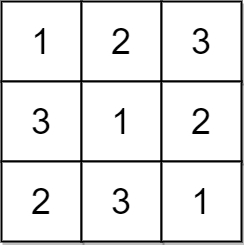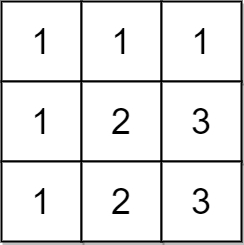2133. Check if Every Row and Column Contains All Numbers
An n x n matrix is valid if every row and every column contains all the integers from 1 to n (inclusive).
Given an n x n integer matrix matrix, return true if the matrix is valid. Otherwise, return false.
Example 1:

Input: matrix = [[1,2,3],[3,1,2],[2,3,1]]
Output: true
Explanation: In this case, n = 3, and every row and column contains the numbers 1, 2, and 3.
Hence, we return true.Example 2:

Input: matrix = [[1,1,1],[1,2,3],[1,2,3]]
Output: false
Explanation: In this case, n = 3, but the first row and the first column do not contain the numbers 2 or 3.
Hence, we return false.
Constraints:
n == matrix.length == matrix[i].length1 <= n <= 1001 <= matrix[i][j] <= n
Solution
Version 1: o(n*n)
'matrix' must consist of values from 1 to 3 only
所以我们可以用SET去重在做
Time: O(n^2)O(n2)
Space: O(n)O(n)
如果没有testcase限制, 'matrix' must consist of values from 1 to 3 only ,可以加上min, max控制:
Version 2: 空间换时间
Previous2134. Minimum Swaps to Group All 1's Together IINext632. Smallest Range Covering Elements from K Lists (H)
Last updated
Was this helpful?